Immigration has become an increasingly prominent political issue, heightened by the sharp increase in people coming into the country across the southern border.
While studies show it’s good for the economy overall to let more people into the country, they also show that some Americans benefit more than others, and some end up being worse off. It also matters who comes in and how. Poorly regulated immigration contributes to problems not readily apparent when looking from a purely economic point of view, some experts argue.
Who Benefits?
A growing body of research shows that immigration boosts the economy in the long term.An upcoming paper by professor Tarek Hassan, a Boston University economist, estimates that an influx of 12,000 new immigrants into an average U.S. county boosts its per capita patent filing by native population by 30 percent and the average wage of natives by 5 percent—all within five years. The wage effect would then perhaps double over the next few decades before gradually fading away.
The dynamic behind the results, Mr. Hassan told The Epoch Times, could be described as a “battle between two forces.”
“When more migrants arrive … they should be driving down wages, because more workers should mean lower wages for everyone,” he said.
“But at the same time, we also believe that economic growth comes from just more people being able to sit down and think about ideas.”
The paper demonstrates that the latter effect “wins out,” he said. The theory is that the production and consumption of the new immigrants makes for a larger economy, which is then able to support more higher paid jobs.
Yet the study results, shared with The Epoch Times, indicate it’s the highly educated immigrants who bring the bulk of the benefits. Low-educated immigration caused negative effects on both innovation and education, the results showed, but neither figure was statistically significant—the margin of error was too large.
“It is true that more educated immigrants have more positive effects,” Mr. Hassan acknowledged.
That’s where the distinction between legal and illegal immigration comes into play.

Mr. Hassan’s paper concluded that highly educated Americans benefited the most from immigrant inflow. Those with at least 5 years of college had their wages go up much more than those with 4 years of college. The wages of those with less education barely budged. Those lacking a high school diploma had their wages slightly drop, although again, the figure wasn’t statistically significant.
Prof. Giovanni Peri, an economist at the University of California–Davis, used a different method to discern the effects of immigration on wages and employment of native workers. His results seem to clash in part with Mr. Hassan’s.
In an April paper, co-authored with Alessandro Caiumi, Mr. Peri concluded that immigration resulted in somewhat higher wages and higher employment for less educated native workers, but had virtually no effect on the more educated ones in the 2000-2019 period.
New immigrants did cause wages to go down for some people—other immigrants, he found—but only those with high school or higher education.
Mr. Peri noted that low-education immigrants often come illegally and work either off the books or ask for asylum, which allows them to get a work permit while their case is pending.
“The problem is that the large majority of these people will not get asylum,” he told The Epoch Times.
Indeed, those crossing the southern border often flee crime in their home country or seek better employment, neither of which are grounds for asylum, which is reserved for people facing persecution.
Based on his results, Mr. Peri proposed opening a way for low-education immigrants to come to the country legally to fill jobs often picked up by illegal immigrants in restaurants, hotels, on farms, and as aides for the elderly.


“We would be able much more to track and know what’s going on with them. It would be much more orderly,” he said.
Mr. Peri’s paper did find some negative effects of immigration on native employment, but only among less experienced workers with less than high school.
Both Mr. Hassan and Mr. Peri also noted that their research looks at average immigration effects.
“There are many microeconomic studies that have documented wages going up or down for specific groups in specific places at a specific point in time,” Mr. Hassan said.
Fiscal Impact
Whatever the economic benefits of immigration, it should be balanced against how much it costs the taxpayer, some experts have argued. Illegal immigration is particularly expensive because it burdens the immigration enforcement apparatus.“In a country where you’re trying to provide the procedural process associated with Western civilization, our constitutional norms, a fundamental fairness and a quasi-judicial proceeding, where you have hearing after hearing on removal proceedings, it’s very expensive to try to get someone out of the country,” said Daniel Stein, president of the Federation for American Immigration Reform (FAIR), which advocates for significantly lower immigration.

Many illegal immigrants also work off the books so they don’t pay income taxes.
Even if they do pay taxes, however, on average they still end up being a fiscal drain simply because of not making enough money, according to Steven Camarota, director of research at the Center for Immigration Studies (CIS), which also advocates for lower immigration.
“U.S.-born people and legal immigrants who make $15, $18, $20 an hour are typically a fiscal drain, too,” he told The Epoch Times.

“But they’re already here.”
It may be that restaurants, hotels, and landscaping firms do need more workers, he said.
Beyond Economy
Much of the complaints about illegal immigration transcend economic concerns.Because immigration enforcement is so cumbersome, in many cases the government “doesn’t even try,” Mr. Stein said.
But that reality tears at the fabric of society in his view.
“You destroy the principle that the rule of law is universally applied,” he said.
It’s also unhealthy for the economy to rely on foreign labor, he argued.
He pointed to the historically low labor force participation for productive-age men.

The issue has been ascribed to multiple causes, but Mr. Stein argues foreign labor is one of them.
Mr. Hassan was doubtful.
“I think that is speculation, and I do not know of any evidence supporting this claim. Moreover, I would expect it to be quite unlikely given we find a null effect on wages. How would immigrants push natives out of the labor market if not by depressing their wages?” he responded via email.
“Moreover, one of our findings … is that an increase in local immigration causes more natives to move to the area. If they were on average leaving the labor force one would expect the opposite!”
Mr. Stein, however, attributed his belief to a more long-term cultural shift rather than economic factors.
“There’s also a class basis for native-born participation [in labor],” he said.
It used to be that American youth picked up menial, service jobs as a rite of passage.

“That’s how you learn the habits of being a good citizen and a work ethic.”
With the increased reliance on foreign labor, parents no longer feel like sending their children to such jobs and the youth can’t see themselves fitting in. Often, they might not even speak the language of their co-workers.
There’s also the effect of “network recruitment,” he said, where managers would hire from the community where they already have contacts.
Unprecedented Accommodations
It’s somewhat hard to pinpoint how many people have actually come into the country since the recent influx started in 2021, several experts said.The foreign-born population has grown about 6.6 million since 2021—"an unprecedented growth rate,” Mr. Camarota noted.
Of those people, CIS estimated about 3.8 million are illegal immigrants. That’s much less than how many people the Border Patrol caught or at least saw coming across the border, but that’s to be expected, according to Mr. Camarota.
Illegal immigrant population naturally dwindles over time, he pointed out. Every year, some are deported, some move out of the country, some marry Americans and obtain legal status, some die. Their children born in the U.S. are automatically citizens, so their population only grows with new arrivals.
Besides its size, however, there’s something else that’s different about the new arrivals—the way they are accommodated, noted Simon Hankinson, a senior fellow in Border Security and Immigration Center at the conservative Heritage Foundation.
“I’ve been following immigration for 30-odd years. And I have never seen a situation where like New York City, for example, had written a blank check where they would house and feed an unlimited number of people who showed up,” he told The Epoch Times.
Such level of accommodation may hinder assimilation, he suggested, concentrating immigrants in their own enclaves.
The idea of a “melting pot” was that people from all over the world “were able to, in a generation or two, adopt the same basic principles about freedom of speech, hard work, individual responsibility and so on. And they went to public schools. And so they shared a certain consensus of views, even if they were different politically,” he said.

“If you concentrate people in very large numbers, in communities where they don’t really interact at all with natives or people from other communities, then as you’ve seen in Europe, and I think we may see in America, that assimilation process takes a lot longer.”
Social and political factors may indeed be more of a reason to regulate immigration that purely economic ones, Mr. Hassan said.
“Immigration has political and social effects that somehow limit the total capacity of society to absorb immigration. I think we’re nowhere near the point where the economy cannot absorb people anymore. But we might be near the point where society just doesn’t want any more immigration. And that’s really a debate that I think should be had, and it’s not being had, because of just all this polarization and people are really not interested in the subtle differences here,” he said.
“And so it’s pretty clear to me that there should be some political decision about how much migration we want, keeping in mind that immigration is good for the economy.”















